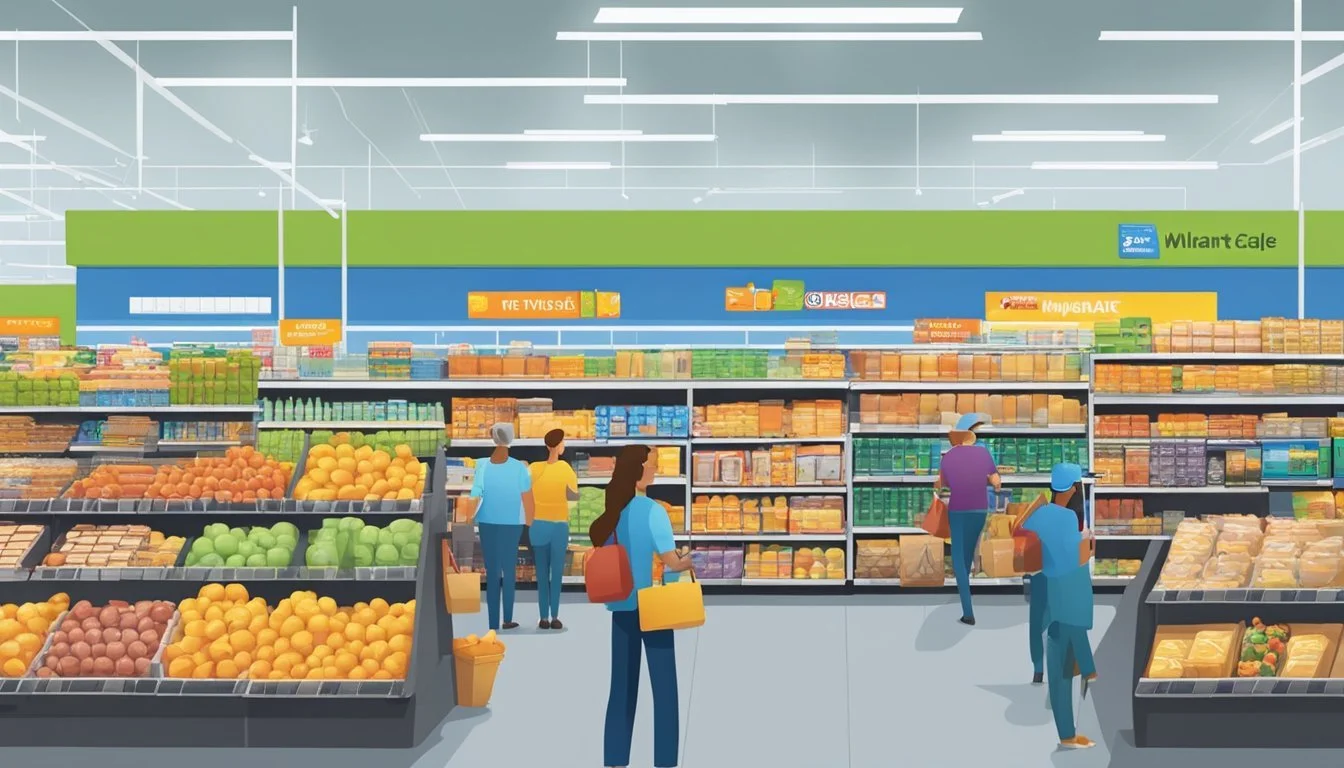Walmart vs Giant Eagle
Comparing Shopping Experiences and Value
Part of Our Grocery Store Guide with Details on Walmart and Giant Eagle
When consumers decide where to do their grocery shopping, price and quality are two of the most critical factors. Walmart, known for its 'Everyday Low Price' guarantee, positions itself as a leader in affordability in the grocery sector. This cost-saving promise has helped Walmart become a go-to destination for shoppers looking to stretch their dollar further, especially when compared to other grocery chains.
Giant Eagle, on the other hand, offers a different appeal to its customer base, with a strong presence in local communities as a popular grocery option. Despite having higher prices on some items, as comparative shopping has shown, the store may provide a different sort of value through its product offerings and shopping experience. When assessing Walmart's lower prices against Giant Eagle's localized approach, the question of which store is better does not yield a one-size-fits-all answer and often depends on the individual shopper's priorities.
To determine which grocery store holds the upper hand, a careful analysis of various factors such as brand recognition, product variety, quality, and customer service is necessary. While Walmart may often prove cheaper, with total costs frequently falling below $100, Giant Eagle may offer distinct advantages that resonate with consumers who prioritize factors beyond the price tag.
Company Overviews
When assessing the value provided by grocery store chains such as Walmart and Giant Eagle, it is essential to consider their historical backgrounds and evolution in the retail market.
History of Walmart
Walmart began as a single discount store in Rogers, Arkansas in 1962, founded by Sam Walton. It set out with the primary aim to offer lower prices and greater service to its customers. The company quickly grew to become a retail giant globally, with a focus on everyday low prices. Walmart now operates a vast network of stores in various formats—including supercenters, discount stores, and neighborhood markets—as well as a significant e-commerce presence.
History of Giant Eagle
Giant Eagle has its origins in Pittsburgh, Pennsylvania, where it was established in 1918. Founders such as the Goldstein, Porter, and Chait families merged their grocery companies, and by 1928, the Eagle chain had grown significantly. Giant Eagle is known for offering a variety of services, such as pharmacy, banking, and dry cleaning, in addition to its grocery selection. While it has a smaller footprint than Walmart, Giant Eagle maintains a strong presence in the regions it serves, with numerous locations and a reputation for quality and customer service.
Store Footprints
The footprint of a grocery store chain is an important factor in understanding its market presence. It can be measured by both the number of locations a chain operates and the size of its individual stores.
Walmart Store Size and Locations
Walmart operates on a grand scale both in the United States and internationally. It boasts a massive number of stores across various formats, including Walmart Supercenters, Walmart Discount Stores, and Walmart Neighborhood Markets.
Supercenters: These are large facilities that typically cover 178,000 square feet.
Discount Stores: Smaller than Supercenters, with an average size of 105,000 square feet.
Neighborhood Markets: Typically around 38,000 square feet in size.
In terms of distribution, Walmart has over 4,700 stores in the United States and more than 6,000 stores internationally.
Giant Eagle Store Size and Locations
Giant Eagle has a more regional footprint, focused primarily in the Northeastern United States. Though smaller in number, Giant Eagle stores are known for their quality and service.
Average Store Size: Most stores are around 75,000 to 100,000 square feet, offering a full-service grocery experience.
Number of Locations: Giant Eagle operates approximately 470 stores, with a strong presence in Ohio and Pennsylvania.
The company has made significant efforts to cater to localized tastes and preferences within its market areas.
Price Comparison
When comparing two prominent grocery chains, Walmart and Giant Eagle, it becomes clear that prices play a significant role in consumers' shopping decisions. This section will analyze the pricing strategies of both stores and provide a direct comparison of grocery staples.
Walmart Pricing Strategy
Walmart is known for its competitive pricing strategy, reaching a broad customer base with its everyday low prices. The store incorporates a combination of large-scale purchasing power and cost-efficiency to keep prices lower than many competitors. For instance, Walmart's pricing for general grocery staples like milk, eggs, and cheerios is often at a discount compared to other retailers.
Giant Eagle Pricing Strategy
Giant Eagle, while not always competing on the lowest price point, focuses on providing value through a mixture of quality offerings and targeted discounts. They offer a loyalty program that can lead to savings on purchases and fuel, which can indirectly lower the overall cost on their groceries like lettuce, potatoes, and carrots.
Comparing Grocery Staples Prices
A side-by-side comparison of select staples illustrates the price differences between Walmart and Giant Eagle:
Grocery Item Walmart Price Giant Eagle Price Dozen Large Eggs $1.08 $1.59 Cheerios (box) $2.98 $3.79 Gallon of Milk $2.78 $3.19 Head of Lettuce $1.28 $1.89 5lb Potatoes $2.47 $2.99 1lb Carrots $0.74 $1.29 24oz Tomato Sauce $0.92 $1.49 Cheddar Cheese (8oz) $1.96 $2.59
Walmart often provides lower prices across the board for many common grocery items, which can lead to significant savings for shoppers on a budget. Giant Eagle's prices are generally higher, but it emphasizes quality and offers more frequent sales and promotions that can reduce the price gap on certain products.
Product Range and Quality
In the competitive landscape of grocery retail, product range and quality often determine where consumers choose to shop. Walmart and Giant Eagle offer distinct selections and quality levels across their product lines, including store brands, organic produce, and a variety of groceries.
Walmart's Product Offerings
Walmart is reputed for having a vast product range that caters to an array of consumer needs. Their offerings encompass dry goods, frozen foods, and fresh produce. Walmart brand products, also known as Great Value, offer consumers an affordable alternative to national brands without sacrificing quality. Furthermore, Walmart has expanded its selection of organic produce to meet the growing demand for healthier food options.
Dry Goods: A wide assortment, including Great Value and other familiar brands.
Frozen Foods: Extensive variety, from meals to desserts.
Fresh and Organic Produce: An expanding selection that includes organic options.
Giant Eagle's Product Offerings
Giant Eagle's product offerings prioritize quality and often cater to a more regional or localized taste palate. While Giant Eagle may have a smaller overall product range in comparison to Walmart, they provide a competitive selection of store brand items under their own labels like Nature's Basket, which is Giant Eagle's line of organic and natural products.
Store Brands: Including Nature's Basket for organic preferences.
Fresh Produce: Focuses on quality and locally sourced options when possible.
Assorted Groceries: A thoughtful selection that balances quality with consumer favorites.
Both retailers have committed to maintaining product quality and offer a variety of options to suit different tastes and dietary needs. Walmart excels in product variety and affordability while Giant Eagle focuses on quality and localized offerings.
Customer Experience
When comparing Walmart and Giant Eagle, shoppers prioritize the overall atmosphere, checkout efficiency, and customer service they experience. These factors significantly impact a customer's perception and loyalty to a grocery store.
Shopping Environment
Walmart stores are known for their large size and a vast selection of items beyond groceries, providing a one-stop-shop for customers. This can be attractive for shoppers looking to save time by purchasing groceries along with other household goods in one trip. In contrast, Giant Eagle focuses more on the grocery shopping experience and offers a cozier atmosphere that some customers may find more pleasant while navigating the aisles.
Checkout Efficiency
Efficiency at checkout is a critical component of the customer experience. Walmart has embraced technology with self-checkout stations to reduce wait times. Additionally, the company has developed smartphone apps, such as Walmart Pay, to streamline the payment process. Giant Eagle also implements self-checkout options, and their fuelperks+ program offers savings that may increase the perceived value of the shopping trip, but they do not prioritize technological solutions to the same extent as Walmart.
Customer Service
Customer service is paramount in grocery retail. Both Walmart and Giant Eagle train their employees to assist customers with questions and concerns, but the level of service can vary from store to store. Giant Eagle generally receives recognition for a more personalized service approach, with individual employees often going the extra mile to ensure customer satisfaction. Walmart's focus on cost savings and operational efficiency can sometimes lead to a perceived compromise in the level of customer service provided.
Brand and Marketing
In the competitive landscape of grocery retail, Walmart and Giant Eagle utilize distinct marketing strategies that hinge on their core brand values. These strategies are crafted to engage customers and harness the power of social media to broaden their respective reaches.
Walmart's Marketing Approach
Walmart emphasizes its 'Everyday Low Price' guarantee as a cornerstone of its marketing strategy. The brand has successfully conveyed this message through a variety of channels, reinforcing the perception of affordability and value. Walmart’s campaigns often showcase a wide range of products at competitive prices, signaling to customers that they can trust Walmart for consistent savings.
Giant Eagle's Marketing Approach
Giant Eagle focuses on personalizing the shopping experience and highlighting its role as a community-oriented retailer. Its marketing efforts tend to emphasize quality, local produce, and customer service. The brand looks to connect with customers who value a blend of convenience with quality offerings, sometimes even at a higher price point than budget retailers.
Social Media Presence
Walmart:
Facebook: Frequent posts featuring promotions, seasonal offers, and interactive content.
Twitter: Engages in customer service and real-time updates, strengthening customer relationships.
Giant Eagle:
Facebook: Focuses on community engagement and local events, promoting a sense of belonging among customers.
Twitter: Less prominent when compared to Walmart but utilizes the platform for customer service and store updates.
Both brands' social media strategies are designed to resonate with their respective target audiences, utilizing these platforms to enhance their marketing reach and support customer engagement efforts.
Additional Services
When comparing Walmart and Giant Eagle, it is not only the prices of goods that matter but also the range and quality of additional services each store offers. Both retailers provide a variety of services beyond just grocery sales that can enhance the shopping experience for customers.
Walmart's Ancillary Services
Walmart offers a comprehensive set of ancillary services aimed at making shopping more convenient for its customers. These services include:
Online Shopping and Delivery: Shoppers can purchase groceries online and opt for home delivery. In many locations, Walmart also offers a curbside pickup service.
Pharmacy: A full-service pharmacy is available at most Walmart stores, providing prescription medications, immunizations, and health screenings.
Walmart Auto Care Centers: Many Walmart stores feature an Auto Care Center, offering oil changes, tire services, and battery installations.
Walmart MoneyCenter: Customers can handle various financial transactions, including check cashing, money transfers, bill payments, and tax preparation services.
Giant Eagle's Ancillary Services
Giant Eagle's array of ancillary services cater to a wide range of customer needs and include:
Online Shopping and Delivery: Giant Eagle provides an online ordering service for groceries with options for both delivery and curbside pickup to accommodate its customer's busy lifestyles.
Giant Eagle Pharmacy: Its in-store pharmacy offers prescription services, flu shots, and other immunizations, supporting the health and wellness of its customers.
Fuel Perks: Giant Eagle operates a fuel reward program which allows customers to earn discounts on gasoline at the company's GetGo stations based on their grocery spending.
Banking: Some Giant Eagle locations include in-store banks or ATMs, further adding to the convenience for shoppers.
Both Walmart and Giant Eagle strive to provide a variety of services that extend beyond just grocery shopping, aiming to create a one-stop shopping experience for their customers.
Competitive Analysis
In this section, we examine how Walmart and Giant Eagle stack up against other supermarkets, taking into account market trends and consumer preferences that shape the competitive landscape of supermarket chains.
Walmart vs Other Supermarkets
Walmart faces stiff competition from a variety of supermarket chains, but it has traditionally maintained a competitive edge due to its aggressive pricing strategy and vast network of stores. Walmart is known for undercutting competitors on price, which includes not only Giant Eagle but also Aldi, Target, and Lidl. While Wegmans and Whole Foods cater to a more upscale market segment, Walmart appeals to budget-conscious consumers looking for necessities at low prices. Amazon has emerged as a formidable competitor, particularly in e-commerce, where it dominates with fast delivery and a wide selection of products.
Price Comparison: Walmart often offers lower prices compared to competitors.
Market Coverage: Extensive presence with locations in numerous communities.
E-Commerce: Challenged by Amazon's dominance in online retail.
Giant Eagle vs Other Supermarkets
Giant Eagle competes in the supermarket segment by focusing on brand recognition and customer loyalty. Unlike Walmart, which competes primarily on price, Giant Eagle emphasizes quality and service, which aligns it more closely with Wegmans and Whole Foods. However, this positioning also means Giant Eagle tends to have higher prices, which can be a disadvantage against discount chains like Aldi and Walmart. The Pittsburgh-based chain competes regionally with Weis Markets and other local supermarket chains, highlighting a tailored approach to community needs.
Brand Recognition: Focuses on maintaining a strong brand presence.
Pricing Strategy: Higher prices, targeting consumers who prioritize quality and service.
Regional Competition: Operates mainly in specific regions, directly competing with local chains.
Market Trends and Consumer Preferences
Consumer preferences and market trends play a crucial role in shaping the competition among supermarket chains. Price sensitivity is a significant factor, with Walmart and Aldi appealing to cost-conscious shoppers, while Wegmans and Whole Foods attract those who prioritize quality and organic options. Convenience is also a growing trend, which Amazon capitalizes on with its quick delivery services. Supermarket chains are optimizing their online presence to meet consumer demand for e-commerce options. Transitioning to digital platforms has become essential to stay competitive, and supermarkets must balance brick-and-mortar operations with online shopping experiences.
Price Sensitivity: Critically important for a large segment of consumers.
Quality and Convenience: Increasingly valued by shoppers, affecting their choice of supermarket.
E-Commerce Growth: Essential for addressing changing shopping behaviors and preferences.
Conclusion
When comparing grocery prices and services, Walmart often emerges with a pricing advantage, as evidenced by several analyses and customer reports. Walmart's strategy of providing 'Everyday Low Price' is attractive to cost-conscious shoppers. For instance, one can typically find lower overall totals for a wide range of items at Walmart, compared to Giant Eagle.
Giant Eagle, however, competes by offering a local and potentially more curated shopping experience. They may provide greater brand recognition in specific locales and sometimes offer free shipping policies which could be a deciding factor for some consumers. While Giant Eagle's prices might be higher for some items, they may offer deals on others, such as canned goods.
On the topic of grocery shopping at Walmart or Giant Eagle, the choice largely depends on the shopper's priorities. For those prioritizing cost above all, Walmart appears to be the preferred option. In contrast, for shoppers valuing brand variety, local recognition, and specific deals, Giant Eagle might be more suitable.
Customers are encouraged to consider their own shopping list and priorities when choosing between these two retailers._individual store surveys and customer service offerings may also influence shopping preferences.








